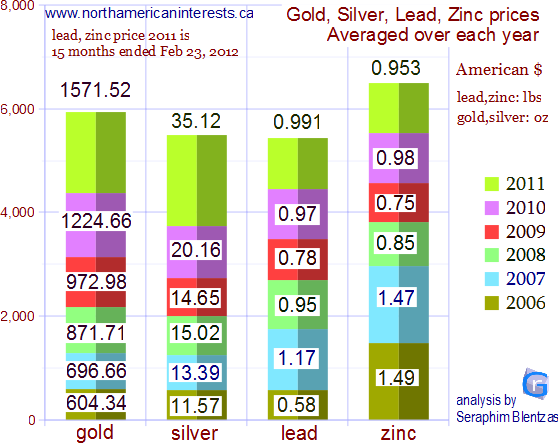Some background on lead
79% of US lead imports made between 2007 and 2010 came from Canada, 15% from Mexico and 3% from Peru. That's slightly changed from the 2004 to 2007 period when 69% of US lead imports came from Canada, 6% from China, 8% from Mexico and 7% from Peru. Strange that China imports went down considering the country now accounts for 48.9% of world primary lead production (2011, +18.9% on year to 2.2 million tons) up from 44.7% in 2010. In 2011 global mine output amounted to 4.52M tons +8.7% versus 2010. Global refined lead production +7% in 2011 to 10.3M tons. US primary mine production has now dropped 5 consecutive years in a row (444th tons in 2007 ---> 345th tons in 2011). The US is home to only 1 primary lead smelter (2011) however a 2nd facility is in the process of being constructed. In 2011 83% of US lead consumption was met by the secondary source, recycling. The US imported 14.0% more lead in 2011 than 2010 (2011 nearly matched 2008's 5 year high of 314th tons), that's despite a drop in US exports (concentrates 299--> 285, refined 83--> 75).
The states of Missouri, Alaska, Idaho, Montana and Washington have traditionally been the source of US lead. Batteries accounted for 88% of consumption in 2008. Another 10% was used in ammunition. Over 100 US manufacturing plants use lead. In the United States over 1 million tons of lead (74% of consumption) is recycled.
Of the world's 1.5 billion tons of lead resource about a third are in Russia (Russia has 11% of global reserves), 20% in North Korea, 17.3% in China (China's reserves are at 14M tons, 16.5% of the world's 85M tons). What's interesting is that China's resources of 380 million tons represent only 44% of its actual resource base (860).
Greece also has significant resources; Its resources of lead are close to 30 million tons 1.36% of the world's total.
Slovakia and Turkey could see more investment from mining companies if lead prices increase since they have much resource that needs to be developed; combined, they hold 5% of global reserves but 13.3% of global reserve base.
Today, a lot of the new supply is coming from mines which produce it as a by-product to silver and zinc mining (Hecla Mining's Green's Creek, Lucky Friday, a few of Rio Tinto's mines).
When prices get too high consumers can easily find replacements for lead. Examples are aluminum, tin and even plastics (plastics have eroded its market share in containers, potable water systems replaced lead with tin). 2011 data courtesy of the USGS's 2011 Commodities Summaries.
